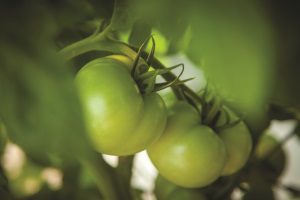The aquaponics process is pretty simple: Fish need water. So do plants. Commercial-scale aquaculture requires controlled temperatures and a filtration system to ensure the fish are healthy. Plants grown in a hydroponic environment need those same things.
requires controlled temperatures and a filtration system to ensure the fish are healthy. Plants grown in a hydroponic environment need those same things.
However, instead of chemicals mixed into the water to encourage plant growth, in an aquaponics system the water is infused with…well, fish poop – but not just any kind of fish poop. It is fish poop that has been biologically converted to remove some naturally-occurring chemical compounds harmful to plants and fish, such as excessive ammonia or nitrites, and recirculated through several deep-water culture troughs in the greenhouse to provide the proper types and amounts of nutrients to the plants.
The filtration process also takes care of a common concern of people unfamiliar with the aquaponics process: Will my salad greens or tomatoes taste fishy? Not at all. As the plants take up the nutrients from the water, the growing plant roots also act as filters, extending the number of times the water can be recirculated instead of pumped back into the environment as wastewater. Plants are very selective in what they carry across their cell walls, ensuring there will never be a fishy tasting vegetable.
When these two processes are connected, the outcome is what Lethbridge College researcher Charlie Shultz refers to as a “balanced system,” where the fish tank is right in (or next door to) the greenhouse, along with a smaller scale filtration system and a waste removal process. “Eventually, we will be testing individual systems, like a homeowner could have,” says Shultz. “This could go a long way to addressing food security issues.”


